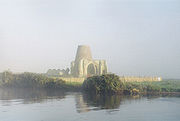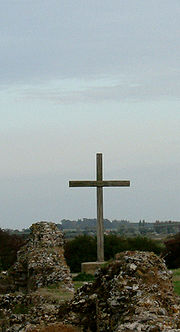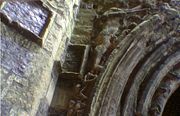
St. Benet's Abbey
Encyclopedia

Ruins
Ruins are the remains of human-made architecture: structures that were once complete, as time went by, have fallen into a state of partial or complete disrepair, due to lack of maintenance or deliberate acts of destruction...
abbey
Abbey
An abbey is a Catholic monastery or convent, under the authority of an Abbot or an Abbess, who serves as the spiritual father or mother of the community.The term can also refer to an establishment which has long ceased to function as an abbey,...
of the Order of Saint Benedict
Order of Saint Benedict
The Order of Saint Benedict is a Roman Catholic religious order of independent monastic communities that observe the Rule of St. Benedict. Within the order, each individual community maintains its own autonomy, while the organization as a whole exists to represent their mutual interests...
situated on the River Bure
River Bure
The River Bure is a river in the county of Norfolk, England, most of it in The Broads. The Bure rises near Melton Constable, upstream of Aylsham, which was the original head of navigation. Nowadays, the head of navigation is downstream at Coltishall Bridge...
within The Broads
The Broads
The Broads are a network of mostly navigable rivers and lakes in the English counties of Norfolk and Suffolk. The Broads, and some surrounding land were constituted as a special area with a level of protection similar to a UK National Park by The Norfolk and Suffolk Broads Act of 1988...
in Norfolk
Norfolk
Norfolk is a low-lying county in the East of England. It has borders with Lincolnshire to the west, Cambridgeshire to the west and southwest and Suffolk to the south. Its northern and eastern boundaries are the North Sea coast and to the north-west the county is bordered by The Wash. The county...
England
England
England is a country that is part of the United Kingdom. It shares land borders with Scotland to the north and Wales to the west; the Irish Sea is to the north west, the Celtic Sea to the south west, with the North Sea to the east and the English Channel to the south separating it from continental...
. It is also known as St Benet's at Holme or Hulme.
Background


Abbey
An abbey is a Catholic monastery or convent, under the authority of an Abbot or an Abbess, who serves as the spiritual father or mother of the community.The term can also refer to an establishment which has long ceased to function as an abbey,...
tradition, was founded on the site of a ninth-century monastery
Monastery
Monastery denotes the building, or complex of buildings, that houses a room reserved for prayer as well as the domestic quarters and workplace of monastics, whether monks or nuns, and whether living in community or alone .Monasteries may vary greatly in size – a small dwelling accommodating only...
where the hermit
Hermit
A hermit is a person who lives, to some degree, in seclusion from society.In Christianity, the term was originally applied to a Christian who lives the eremitic life out of a religious conviction, namely the Desert Theology of the Old Testament .In the...
Suneman was martyred by the Danes. About the end of the tenth century it was rebuilt by one Wulfric. A generation later, c. 1022, its estates of Horning, Ludham and Neatishead were confirmed by King Canute. Other early benefactors included Edith Swannesha, concubine to Harold II
Harold II
Harald II may refer to:* Harald II of Norway * Harald II of Denmark * Harold II of England , a.k.a. Harold Godwinson* Harald Maddadsson, Earl of Orkney and Mormaer of Caithness...
, and Earl Ralf II of East Anglia. In 1065 the abbey established a cell at Rumburgh Priory
Rumburgh Priory
Rumburgh Priory was a Benedictine priory in located in the village of Rumburgh in the English county of Suffolk. The priory was founded in about 1065 as a cell of St Benet's Abbey at Hulme in Norfolk. At the time of the Domesday survey it had 12 monks. The ownership of the priory was transferred to...
in Suffolk
Suffolk
Suffolk is a non-metropolitan county of historic origin in East Anglia, England. It has borders with Norfolk to the north, Cambridgeshire to the west and Essex to the south. The North Sea lies to the east...
.
At the time of the Norman Conquest Harold Godwinson put the abbot
Abbot
The word abbot, meaning father, is a title given to the head of a monastery in various traditions, including Christianity. The office may also be given as an honorary title to a clergyman who is not actually the head of a monastery...
of St Benet's, Aelfwold, in charge of defending the coast against invasion. After the Conquest, Aelfwold fled to Denmark, and the abbey
Abbey
An abbey is a Catholic monastery or convent, under the authority of an Abbot or an Abbess, who serves as the spiritual father or mother of the community.The term can also refer to an establishment which has long ceased to function as an abbey,...
's estates suffered encroachments by neighbouring landowners. The site was enclosed by a wall with battlements in 1327.
Sir John Fastolf, the inspiration for Shakespeare's Falstaff
Falstaff
Sir John Falstaff is a fictional character who appears in three plays by William Shakespeare. In the two Henry IV plays, he is a companion to Prince Hal, the future King Henry V. A fat, vain, boastful, and cowardly knight, Falstaff leads the apparently wayward Prince Hal into trouble, and is...
, was buried here in December 1459, next to his wife Millicent in a new aisle built by Fastolf on the South side of the abbey church.
St Benet's is the only religious house not closed down by Henry VIII
Henry VIII of England
Henry VIII was King of England from 21 April 1509 until his death. He was Lord, and later King, of Ireland, as well as continuing the nominal claim by the English monarchs to the Kingdom of France...
during the Dissolution of the Monasteries
Dissolution of the Monasteries
The Dissolution of the Monasteries, sometimes referred to as the Suppression of the Monasteries, was the set of administrative and legal processes between 1536 and 1541 by which Henry VIII disbanded monasteries, priories, convents and friaries in England, Wales and Ireland; appropriated their...
. Instead he united the Abbacy with the bishopric of Norwich and therefore the Bishops of Norwich
Bishop of Norwich
The Bishop of Norwich is the Ordinary of the Church of England Diocese of Norwich in the Province of Canterbury.The diocese covers most of the County of Norfolk and part of Suffolk. The see is in the City of Norwich where the seat is located at the Cathedral Church of the Holy and Undivided...
have remained abbot
Abbot
The word abbot, meaning father, is a title given to the head of a monastery in various traditions, including Christianity. The office may also be given as an honorary title to a clergyman who is not actually the head of a monastery...
s of St Benet's to this day.
The Bishop of Norwich, as Abbot, arrives once a year, standing in the bow of a wherry
Norfolk wherry
The Norfolk wherry is a type of boat on The Broads in Norfolk, England. Three main types were developed over its life, all featuring the distinctive gaff rig with a single, high-peaked sail and the mast stepped well forward.-Development of the wherry:...
and preaches at the annual service on the first Sunday of August.
After the Dissolution the majority of the buildings at the site, with the exclusion of the gatehouse, were demolished. In the second half of the eighteenth century, a farmer built a windmill, later converted to a windpump
Windpump
A windpump is a windmill used for pumping water, either as a source of fresh water from wells, or for draining low-lying areas of land. Once a common fixture on farms in semi-arid areas, windpumps are still used today where electric power is not available or too expensive.-History:Windmills were...
, inside the abbey gatehouse, removing the second floor in the process. The windmill had ceased operating approximately a century later, falling into ruin itself. On 2 August 1987 a cross
Cross
A cross is a geometrical figure consisting of two lines or bars perpendicular to each other, dividing one or two of the lines in half. The lines usually run vertically and horizontally; if they run obliquely, the design is technically termed a saltire, although the arms of a saltire need not meet...
made from oak
Oak
An oak is a tree or shrub in the genus Quercus , of which about 600 species exist. "Oak" may also appear in the names of species in related genera, notably Lithocarpus...
from the Royal Estate at Sandringham
Sandringham House
Sandringham House is a country house on of land near the village of Sandringham in Norfolk, England. The house is privately owned by the British Royal Family and is located on the royal Sandringham Estate, which lies within the Norfolk Coast Area of Outstanding Natural Beauty.-History and current...
was erected on the High Altar.
Abbots
The years listed are election dates| Year | Names |
|---|---|
| Wulfric | |
| 1020s | Aelfsige |
| 1046 | Thurstan de Ludham Ludham Ludham is a village and civil parish in the English county of Norfolk, in The Broads, at the end of a dyke leading to Womack Water and flowing into the River Thurne... |
| 1064 | Aelfwold |
| 1089 | Ralph |
| 1101 | Richard |
| 1126 | Conrad |
| 1128 | William Basset |
| 1133 | Anselm |
| 1140 | Daniel |
| c. 1150 | Hugh |
| 1151 | Daniel (reinstated) |
| 1153 | William |
| 1168 | Thomas |
| 1186 | Ralph |
| 1210 | John |
| 1214 | Reginald |
| 1229 | Sampson |
| 1237 | Robert de Thorkeseye |
| 1251 | William de Ringfeld |
| 1256 | Adam de Neatishead Neatishead Neatishead is a village and civil parish in the English county of Norfolk. The village is situated some north-east of the city of Norwich, within The Norfolk Broads and to the west of Barton Broad... |
| 1268 | Richard de Bukenham Buckenham Buckenham is a village in Norfolk, England, situated on the northern bank of the River Yare. The village is the location of the RSPB Buckenham Marshes nature reserve.Buckenham railway station serves the outlying communities and the RSPB reserve.... |
| 1275 | Nicholas de Walsham |
| 1302 | Henry de Broke Brook -Places:*In the United Kingdom:**Brook, New Forest, Hampshire**Brook, Test Valley, Hampshire**Brook, Isle of Wight**Brook, Kent**Brook, Surrey**Brook, Carmarthenshire*In the United States:**Brook, Indiana-People:... |
| 1326 | John de Aylsham Aylsham Aylsham is a historic market town and civil parish on the River Bure in north Norfolk, England, about north of Norwich. The river rises near Melton Constable, upstream from Aylsham and continues to Great Yarmouth and the North Sea, although it was only made navigable after 1779, allowing grain,... |
| 1347 | Robert de Aylsham Aylsham Aylsham is a historic market town and civil parish on the River Bure in north Norfolk, England, about north of Norwich. The river rises near Melton Constable, upstream from Aylsham and continues to Great Yarmouth and the North Sea, although it was only made navigable after 1779, allowing grain,... |
| 1349 | William de Hadesco |
| 1365 | William de Methelwold |
| 1395 | Robert de Sancta Fide |
| 1395 | Simon de Brigham Brigham The village of Brigham, near the town of Cockermouth, Cumbria, England, has existed as a settlement since neolithic times.Brigham was an early centre of Christianity in Cumbria... |
| 1411 | Richard de South Walsham South Walsham South Walsham is a village and civil parish in the English county of Norfolk. It is adjacent to South Walsham Broad.It covers an area of and had a population of 738 in 303 households as of the 2001 census.... |
| 1439 | John Marte |
| 1439 | John Kelyng |
| 1470 | Thomas Pakefield Pakefield Pakefield is a suburb of the town of Lowestoft in the Waveney District of the English county of Suffolk. Pakefield is located around 2 miles south of the centre of the town. Although today it forms a suburb of the urban area of Lowestoft, it was until 1934 a village and parish in its own right.... |
| 1492 | Robert Cubitt |
| 1505 | William Forest |
| 1510 | John Redinge |
| 1517 | John Salcot, alias Capon |
| 1530 | William Repps |
Further reading
- Stephen Cooper, The Real Falstaff, Sir John Fastolf and the Hundred Years war, (Pen & Sword, 2010)
External links
- Norfolk Archaeological Trust - Owners of St Benet's at Holme
- St Benet's Abbey Mill History

